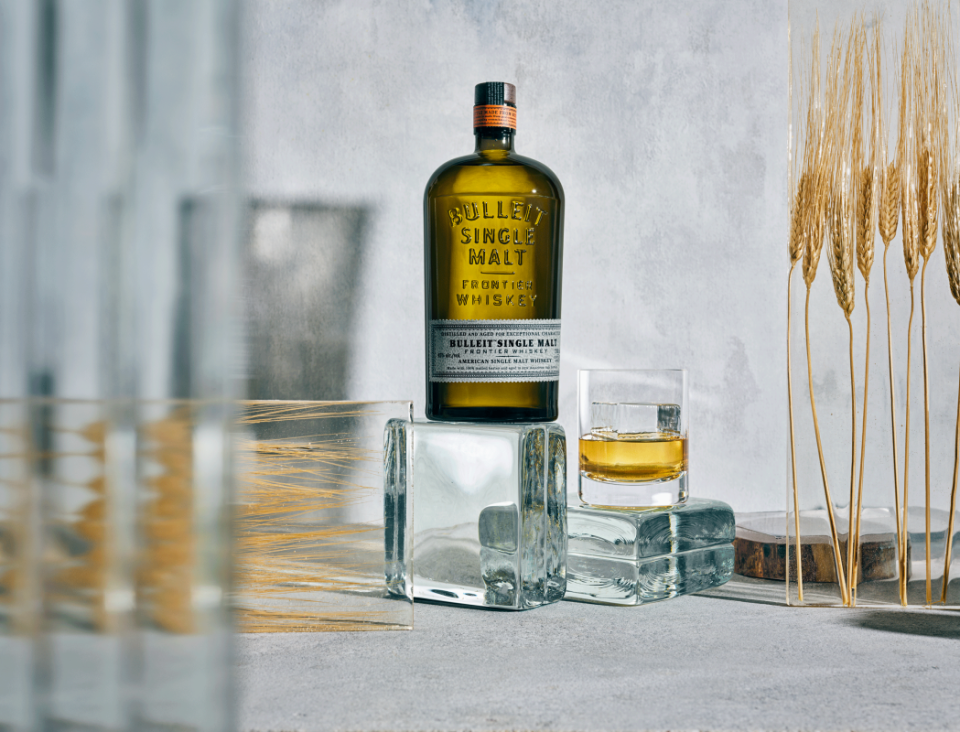Bulleit's New, Limited-Edition Whiskey Is a Turning Point for American Single Malts
American single malt, a fledgling category of domestic whiskey inspired by Scotch, continues to stake out more and more shelf space at your local liquor store. And while it was once primarily the purview of craft upstarts, the style has now attracted the interest of the biggest names in the game.
Bulleit Frontier Whiskey has entered the fold. The same folks behind the enduringly popular bourbon label have unveiled a non-age statement American Single Malt Whiskey, bottled at 90-proof, distilled from 100 percent malted barley, and aged in new charred American oak barrels.
From an ingredient perspective, this new release is quite a departure from Bulleit’s flagship bourbon, which reportedly relies on no more than 4 percent malted barley for its mashbill (along with 68 percent corn and 28 percent rye). So, there’s plenty of difference when it comes to flavor. But fans of the brand will notice another point of separation long before it even touches their tongue. The single malt pours into the glass wearing far lighter copper tones than its bourbon and rye counterparts.

Courtesy of Bulleit
Perhaps unsurprisingly, it noses more like a young Scotch than it does either of those aforementioned American categories. There's an initial grassiness to the bouquet, eventually accompanied by freshly harvested orchard fruit. The sip steers towards fudge and toffee, before more of that initial fruitiness returns for the finish, ultimately joined by oak and cedar. It’s not nearly so robust as a dram filled with, say, Bulleit Bourbon—or even other entries into the nascent category. But that seems to be by design.
“One of the things that people will find with Bulleit American Single Malt is that it’s lighter than other American single malts,” says Phil Gelineau, innovation manager for the brand. “It has a toasted oak backbone, with minimal graininess and maltiness.”
Related: 20 Best Bourbons for an Old Fashioned, Tasted and Reviewed
It’s true, the juice is a stark departure from some of the heartier American single malts we know and love—from folks who've been at it for far longer. Westward Whiskey out of Portland, OR, tends to have a roasted, coffee-like undertone to its malts. Stranahan’s in Denver, CO, is unapologetically oakier in its expressions. Nevertheless, Bulleit did take significant steps to ensure it remained a familiar product to its own loyalists.
“We used new American white oak casks, which are the same casks used for our bourbon,” Gelineau points out. “We also use a proprietary yeast strain, so some flavor elements overlap with our core Bulleit Bourbon.”
But, unlike bourbon, which has narrowly defined production parameters, American single malt remains a largely undefined category. That’s because the federal agency in charge of labeling booze continues to drag its feet over specific guidelines. Until then, you can be met with less-than-savory examples that spend unfortunately little time in the cask, or maybe don’t even use 100 percent malted barley at all.
Amidst all that uncertainty, Bulleit’s entrance provides some measure of reassurance, as it's a novel offering from a brand of proven quality. It arrives on shelves in a green-hued bottle built of recycled glass, conspicuously embossed with the name of the category it’s helping to validate so you won’t be tempted to confuse it with its bourbon or rye stablemates. But it’s certainly happy enough just to hold a place alongside them on your mantle. You can take one home starting this week at a suggested retail price of $60.
Related: We've Tasted Hundreds of Whiskeys. These Are the Best in the World

